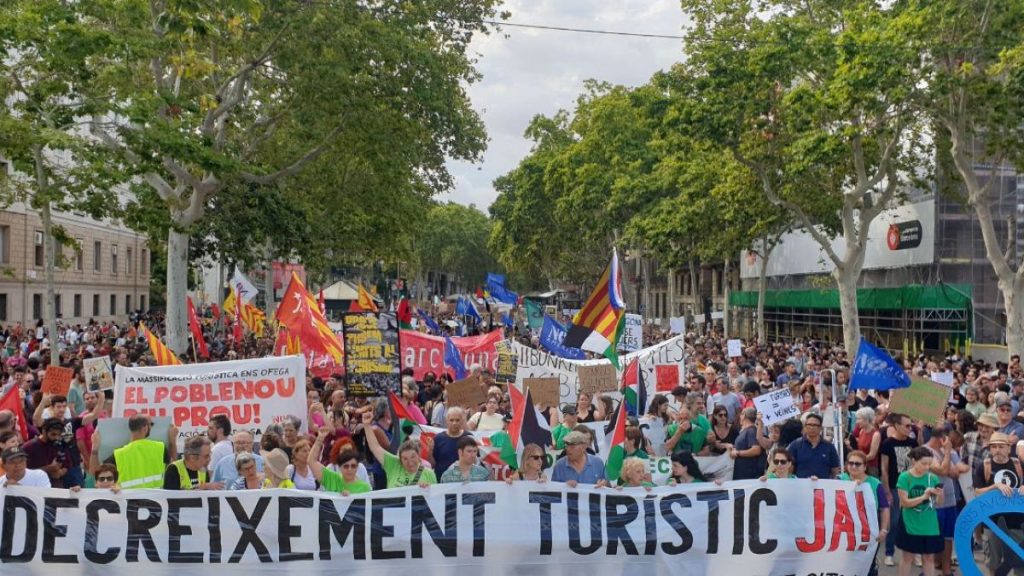The Aftermath of 2024’s Anti-Tourism Protests: A Look Ahead to 2025
The year 2024 witnessed a surge of anti-tourism protests across numerous European destinations, including Amsterdam, Athens, Venice, Barcelona, the Canary Islands, Málaga, and the Balearic Islands. Residents, frustrated by the overwhelming influx of tourists, took to the streets to reclaim their cities, employing marches, campaigns, slogans, and even water pistols to express their discontent. The protests primarily stemmed from concerns about overcrowding, noise pollution, and the escalating housing crisis, which many attributed to the proliferation of tourist accommodations. As we enter 2025, the question remains: what lies ahead for these popular tourist destinations? Will authorities and protestors find common ground, or is the battle against overtourism far from over?
Authorities in various affected cities have responded with a range of measures aimed at mitigating the negative impacts of overtourism. Barcelona’s city council has pledged to eliminate all Airbnb-style accommodations by 2028, taking a significant step in December 2024 with stricter limitations on short-term rentals. Venice implemented restrictions on tour groups and banned megaphones in August 2024. Málaga prohibited new holiday flats in 43 city neighborhoods, while the Canary Islands decreed that 90% of residential areas must be allocated to permanent residences within the next five years. Amsterdam adopted a different approach, launching a "Stay Away" campaign and an interactive quiz designed to educate visitors on proper behavior.
Despite these measures, the underlying tension between the need for tourism revenue and the preservation of local communities persists. Spain, the epicenter of many protests, experienced record-breaking international tourist arrivals in the first ten months of 2024, with projections indicating a further 25% increase in the winter of 2024/25. This surge in tourism raises questions about the effectiveness of current measures and whether they adequately address the root causes of residents’ concerns. Protest groups, such as the Assemblea de Barris pel Decreixement Turístic (ABDT) in Barcelona, argue that authorities are more focused on suppressing anti-tourism sentiment than genuinely addressing the problem. They advocate for a decrease in tourism, citing its contribution to climatic, social, and environmental issues, as well as the housing emergency.
The ABDT calls for a shift away from tourism promotion and mega-events, urging authorities to prioritize a path of tourist decline and eco-social transition. They express skepticism about the Barcelona city council’s commitment to banning tourist apartments, deeming it insufficient and potentially too late. They argue that all forms of tourist accommodation, including hotels, should be reduced to alleviate pressure on the housing market. In the Canary Islands, similar concerns are echoed by Nestor Marrero Rodríguez, secretary of ATAN (Tenerife Association of Friends of Nature). Rodríguez criticizes the authorities for continuing to plan projects that exacerbate environmental degradation and perpetuate poverty within the local community. While acknowledging the creation of a manifesto with measures like a tourist eco-tax and limitations on new constructions, Rodríguez remains skeptical and anticipates further demonstrations in tourist areas throughout 2025.
Amsterdam, while facing similar challenges, presents a slightly different perspective. City councillor Sofyan Mbarki highlights the implementation of over 75 measures to combat the negative effects of overtourism, including regulations on B&Bs and vacation rentals, relocation and reduction of cruises, and a ban on coaches in the city center. While acknowledging the positive impact of these measures, Mbarki emphasizes the need for further action in 2025, including maintaining the ban on new hotels and hotel bed additions, adjusting closing times for cafes and restaurants, and dispersing coffee shops across the city. Amsterdam’s approach appears to be more focused on managing tourism rather than actively discouraging it.
The contrasting approaches adopted by different cities reflect the complex and multifaceted nature of overtourism. While some advocate for a reduction in tourist numbers, others focus on managing the flow and behavior of visitors. The effectiveness of these strategies remains to be seen, and it is likely that 2025 will be a crucial year in determining the future trajectory of tourism in these European hotspots. Ultimately, finding a sustainable balance between the economic benefits of tourism and the well-being of local communities will be the key challenge moving forward. This may involve not only implementing regulations but also fostering greater dialogue and understanding between residents, tourists, and local authorities. The continued involvement of protest groups suggests that the debate is far from settled, and the coming year promises further developments in the ongoing struggle to address overtourism.














